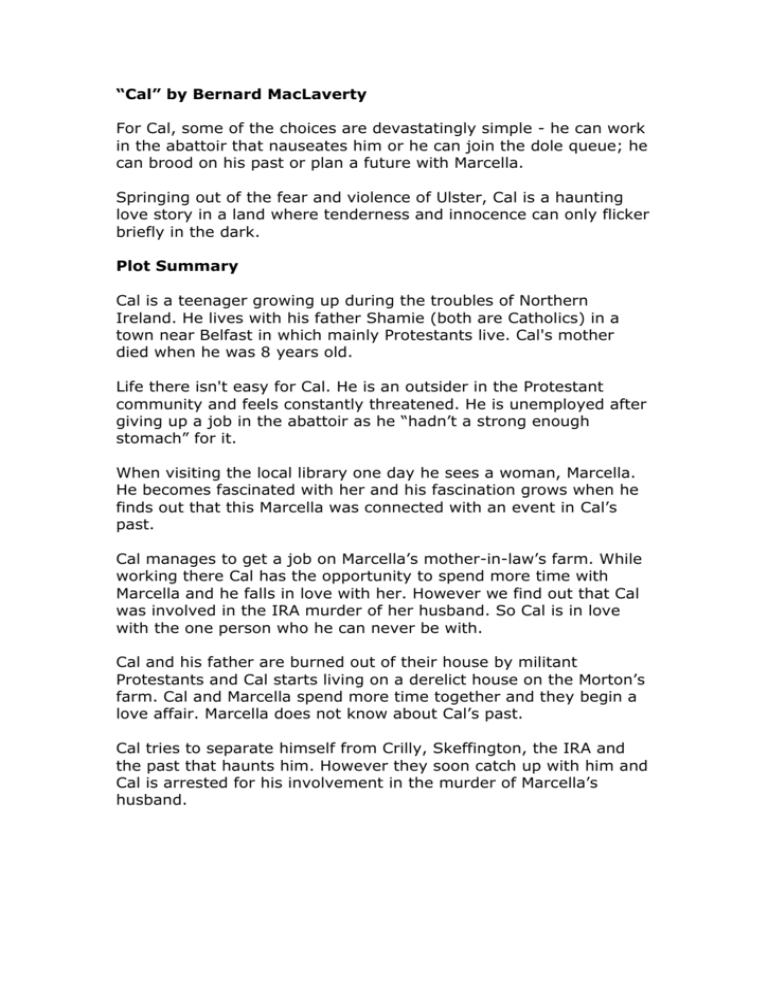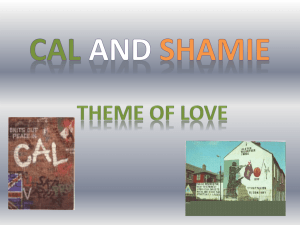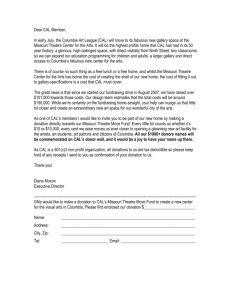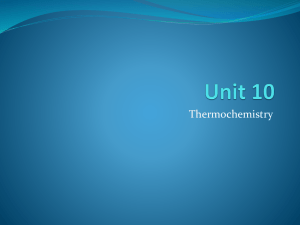“Cal” by Bernard MacLaverty
advertisement

“Cal” by Bernard MacLaverty For Cal, some of the choices are devastatingly simple - he can work in the abattoir that nauseates him or he can join the dole queue; he can brood on his past or plan a future with Marcella. Springing out of the fear and violence of Ulster, Cal is a haunting love story in a land where tenderness and innocence can only flicker briefly in the dark. Plot Summary Cal is a teenager growing up during the troubles of Northern Ireland. He lives with his father Shamie (both are Catholics) in a town near Belfast in which mainly Protestants live. Cal's mother died when he was 8 years old. Life there isn't easy for Cal. He is an outsider in the Protestant community and feels constantly threatened. He is unemployed after giving up a job in the abattoir as he “hadn’t a strong enough stomach” for it. When visiting the local library one day he sees a woman, Marcella. He becomes fascinated with her and his fascination grows when he finds out that this Marcella was connected with an event in Cal’s past. Cal manages to get a job on Marcella’s mother-in-law’s farm. While working there Cal has the opportunity to spend more time with Marcella and he falls in love with her. However we find out that Cal was involved in the IRA murder of her husband. So Cal is in love with the one person who he can never be with. Cal and his father are burned out of their house by militant Protestants and Cal starts living on a derelict house on the Morton’s farm. Cal and Marcella spend more time together and they begin a love affair. Marcella does not know about Cal’s past. Cal tries to separate himself from Crilly, Skeffington, the IRA and the past that haunts him. However they soon catch up with him and Cal is arrested for his involvement in the murder of Marcella’s husband. Themes The main themes of the novel are: Politics of Northern Ireland and “The Troubles” Violence Religion Suffering Guilt The book shows the tragic consequences on individual lives of the hatred between the Catholic and Protestant communities. The following characters could all be regarded as victims of the political situation in Northern Ireland: Cal Shamie Robert Morton Marcella Setting The location of the events and characters in Northern Ireland during “The Troubles” is crucial to all aspects of the novel and is inseparable from the themes of the book. The setting can be seen as an all-powerful force which shapes and controls the characters. It creates a violent, threatening and oppressive atmosphere which forces people into choosing sides and committing acts of violence. We can see the conflict between Catholic and Protestant; IRA and Loyalist/British, and the effect that this has on characters, especially Cal and his father, Shamie. Cal and Shamie live under constant threat because of their religion. They are the only Catholic family in a Protestant neighbourhood. Shamie is determined not to be forced out of his home but this leads to acts of violence. First Cal is attacked by some loyalist youths and then their house is set on fire. Shamie never recovers from this and it leads to him having a breakdown. Shamie can be seen as one of the many victims of the Troubles of Northern Ireland. We also learn that Cal is involved with the IRA. Cal is instinctively against the violence that blights his community but he is unable to escape it. Crilly and Skeffington force him to continue to help the IRA. It is clear that because Cal is a Catholic in Modern Northern Ireland, he has no choice but to follow a certain path and undergo suffering. Characters - Cal The novel gives readers an insight into how “The Troubles” affected ordinary people and their lives. This is done by presenting the events of the novel from Cal’s viewpoint. The author thus faces the difficult task of asking the reader to sympathise with, and respond favourably towards, a member of the IRA. To do this he shows us an individual with problems, and some endearing or redeeming qualities. Find four problems that Cal has, and four qualities. Problems Qualities 1. Why does MacLaverty leave making the reader aware of Cal’s involvement in the murder until about half-way through the novel? 2. Who or what has shaped Cal’s personality and outlook? What motivates this character? 3. It could be argued that Cal’s relationship with Marcella was doomed from the start, so why does he pursue her so relentlessly? 4. What is your overall attitude towards Cal? How do you feel about him at the end of the novel? It is central to the writer’s purpose that we sympathise with Cal. The writer achieves this by showing us all his endearing qualities; his shyness, his quirky sense of humour, his “innocence”, his kindness, his lack of confidence and his care and concern for his father. The bleakness of Cal’s life, especially at the beginning of the novel, and the fears and threats he has to live with every day from both sides, adds to our sympathy for him. Also his isolation: he has no real friends or family to turn to, especially when his father breaks down at the end. The only real relationship in Cal’s life is with Marcella. That relationship is doomed to failure as he struggles with the burden of guilt and remorse for the death of her husband. The less attractive side of Cal’s nature; his involvement with violence and the IRA is overcome because: He is sorry for what he has done. He is tortured by guilt and remorse. At one point he talks of going to his room “to eat again the ashes of what he had done”. He is a reluctant participant in violent and criminal activities and he tries desperately to get out. He contrasts markedly with characters like Crilly - the mindless thug, who seems to enjoy violence and who doesn’t stop to question what he does in human or moral terms. To the likes of him, the issue is simple - the “enemy” (the Brit or Ulsterman) must be eliminated in the struggle to free Ireland. Likewise Skeffington, the IRA “intellectual” who gets other people to do his dirty work for him. Characters - Marcella Marcella's family comes from Italy. She is small, dark-haired and she has brown eyes. About five years before the beginning of the story, she married Robert Morton, a Protestant from Ulster. Marcella herself is a Catholic. Since her husband was murdered by militant Catholics, Marcella lives with her little daughter Lucy in the farmhouse of her parentsin-law. She works in a library to get out of her boring life at home. She is discontent with her life because she feels alone with her thoughts and problems. Task: List as many reasons as you can to explain why a woman like Marcella would become involved with someone like Cal. The following quotes might help you: “I think that’s a terrible thing about marriage. You have to move away from your own home to be with your husband and leave your friends. Then bang - you’re left without anything.” “It frightens me that people should want physically to hurt one another.” “It seems terrible at my age to be nostalgic for school.” “Love is a very strange idea... when you were young it seemed to be all intensity and no opportunity. Later when you did get the opportunity the fire had gone out if it.” Characters Shamie Though we see little of him, Shamie comes across as an ordinary working man whose life is ruined by the violence and hatred of Ulster. He is reduced to a state of helplessness and despair. This is a strong contrast to the tough manly image he presents at the start of the novel. Crilly and Skeffington These men are very much involved in the struggle for “the cause”, but represent different faces of nationalism and terrorism. Think about their personality, behaviour and motivation. What is your attitude towards each of them? Task: Find quotes for the following: Cal’s bleak life His isolation His fear of violence The constant threat that he lives under His guilt His reluctance to take part in violence His love for Marcella “As he turned into the street he felt the eyes on him.” pg 2 “the kerbstones had been painted alternating red, white and blue. Cal felt it was aimed at them, the McCluskeys, because his father and he were the only Catholic family left in the whole estate.” pg 3 “Sometimes he wished he knew more languages to curse himself more thoroughly.” pg4 “It was her. ...In some way, he didn’t know how, he would have to make it up to her.” pg 10 “he went to the bedroom to eat again the ashes of what he had done.” pg 10 “‘What’s the problem, Cahal?’ Skeffington asked. ‘I just don’t like what’s happening. That woman Marcella Morton has started in the library. I see her every day.’” pg18 “I have no stomach for it” pg 18 “The rest of his prayers consisted of telling himself how vile he was.” pg 33 “‘We’ll get you next time’... The trouble was he knew they would. It had been a chance encounter, fists and feet. Next time it would be clubs, pick-handles, knives or worse.” pg 43 “‘If you’re not part of the solution, you’re part of the problem.’ ‘But it all seems so pointless,’ said Cal. pg 64 “Cal shouted to one of the firemen, ‘Is my father in there?’ His voice was almost a scream.” pg 73 “He felt like he had a brand stamped in blood in the middle of his forehead which would take him the rest of his life to purge.” pg 89 “Sometimes in her presence he felt like Quasimodo - as if the ugliness of what he had done showed in his face.” pg125 “She would probably laugh...if he gave her the slightest hint that he loved her.” pg125 “He wanted to share his guilt with the person he had wronged. To commune with her and be forgiven.” pg 143 “The next morning the police arrived to arrest him and he stood... listening to the charge, grateful that at last someone was going to beat him to within an inch of his life.” pg156 Example: Point: Cal feels remorse for what he has done in the past. Context: When he finds out that the woman in the library is connected to his past he feels a need to make it up to her: Quote: “It was her. ...In some way, he didn’t know how, he would have to make it up to her.” Explanation: At this point in the novel we do not know what Cal has done but this clearly shows that he regrets it and wants to make amends. Themes The novel explores many themes but the main ones are politics, violence, religion, suffering and, above all, guilt. The main theme of the book is the tragic consequences on individual lives of the bitter inbred hatred between Catholic/Protestant and Republican/Loyalist. This hatred and conflict controls all aspects of a person’s life; where he works, where he lives, who his friends are, who he falls in love with, how he spends his time. The novel clearly shows the impossibility of trying to break free from this hatred. Cal is thus an isolated, lonely figure, alienated because of his religion. His is unable to accept the role expected of him by the IRA because he cannot accept the violence and suffering it inevitably leads to. He also cannot escape the guilt that he feels from his previous involvement with the IRA. His feelings of guilt and selfhatred lead him to seek forgiveness or salvation through his relationship with Marcella. Match the themes below with the quotes: Guilt “‘If you’re not part of the solution, you’re part of the problem.’ Pg 64 Need for forgiveness “he went to the bedroom to eat again the ashes of what he had done.” pg 10 The difficulty of breaking free from the hatred and conflict of Northern Ireland “He wondered how many people had cracked up like Shamie as a result of the troubles. Shaking remnants of themselves.” Pg 114 “He wanted to share his guilt with the person he had wronged. To commune with her and be forgiven.” pg 143 Violence The tragic effect of the troubles on individual lives. “‘We’ll get you next time’... The trouble was he knew they would. It had been a chance encounter, fists and feet. Next time it would be clubs, pick-handles, knives or worse.” pg 43 Themes – Questions 1. The tragic effect of the troubles on individual lives. Show how the lives of the following characters are affected by the troubles: Marcella Shamie Cal 2. Violence. Choose a scene from the novel which shows us the violent world in which the novel takes place. Describe what happens in the scene. 3. Guilt. Do you think Cal is right to feel guilt for his role in the murder of Marcella’s husband or is he a victim of circumstances? Give reasons for your answer. 4. Forgiveness. Cal has a need for forgiveness. Do you think Marcella would forgive Cal when she finds out about his involvement in the murder? Is forgiveness the only way that Northern Ireland can move beyond the violence and hatred? Structure The novel consists of five chapters, starting with Cal’s fear and isolation, then his meeting with Marcella, the burning of the house, the flashback to the murder and Cal’s guilt in helping to carry it out, the consummation of the relationship between Cal and Marcella and his arrest. Each chapter is in sections which move back and forth in time and place and include flashbacks. Dramatic effects are achieved by the intrusion of violent action, or nightmares. Through chapters 1-3 there are many strong hints of guilt, so the reader is not really surprised when we are told exactly what he had done. However the timing of the revelation is important because: 1. Cal has just been forced into doing another “job” for the IRA 2. His home has just been burned to the ground. So we are feeling sorry for Cal at this point. We are willing to show him sympathy even though he has been involved in a murder. Symbolism 1. The abattoir. Events here represent what happens in Belfast – the blood, the violence, the killings. Introduces us to Crilly with a knife. 2. The martyrs. Cal is constantly reminded of these religious men and women who represent the idea that you can only find forgiveness or salvation after you have endured you have endured severe physical punishment. 3. Nightmares. In all three of Cal’s nightmares he is represented as a helpless individual unable to prevent disaster. They are also violent and bloody – reflecting the violent world of Northern Ireland. 5. http://www.bbc.co.uk/learningzone/clips/how-do-you-bringa-divided-community-together/7350.html Choose a novel in which the central character is involved in conflict. Briefly outline the nature of the conflict and then in more detail explain how it helped illustrate the theme(s) of the novel. In your answer you should deal with at least two of the following: setting, characterisation, dialogue, key incident, theme, or any other appropriate feature. Choose a prose work (fiction or non-fiction) in which setting is an important feature. Explain how the writer creates the setting, and then go on to show how this feature contributes to your understanding of the text as a whole. Choose a novel or a short story which gives you an insight into an aspect of human nature or behaviour. State what the aspect is, and show how the characters’ actions and relationships lead you to a deeper understanding of human nature or behaviour. Choose a novel or a short story in which a character is in conflict with his or her friends or relatives or society. Show how the conflict arises and what effect it has on the character’s fate in the novel or short story as a whole. Choose a novel or a short story which deals with the effects of evil or war or deceit or a breakdown in society or a breakdown in relationship(s). Show how any of these negative pressures affects the main character in the novel or short story and go on to show whether or not she or he tackles it successfully. Choose a novel or short story in which you feel sympathy with one of the main characters because of the difficulties or injustice or hardships she or he has to face. Describe the problems the character faces and show by what means you are made to feel sympathy for her or him. Choose a prose text (fiction or non-fiction) in which a society or a person or a culture or a setting is effectively portrayed. Show how the writer’s presentation of the subject makes an impact on you, and helps you to understand the subject in greater depth. 6. Choose a novel or short story which has a striking opening. Show how the opening is effective in introducing the character(s) and/or the atmosphere and/or the setting.








